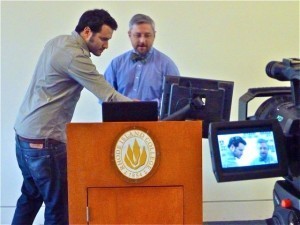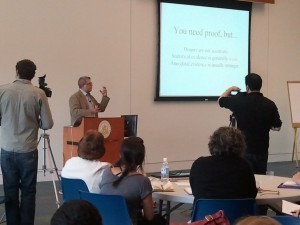Marc A. Pitman's Blog, page 51
September 10, 2012
50% off fundraising training module
I’m honored to be part of the new FundCoaches.com! The creators of FundCoaches.com were frustrated with how hard it was to find CFRE accredited training that didn’t cost and arm and a leg.
So they got people like Tom Ahern, Simone Joyaux, Ted Hart, Marcy Heim, and myself on video teaching some of our best fundraising tactics.
And they’ve given me a special 50% off code for my readers. To redeem the 50% off, go to FundCoaches.com and choose whichever course you want. Then use the special code NLSBINUP in the shopping cart.
There’s a lot of terrific training on this site. And they keep adding more!
(c) The Fundraising Coach, LLC
Get 100 donors in the next 12 weeks? Learn how: 100 Donors in 90 Days!
Other Possibly Related posts:
FundCoaches: A revolution in fundraising training
Fundraising Training Videos now available online!
SPECIAL: Free Fundraising Coaching 1-on-1 Call with purchase of Fundraising Training
September 7, 2012
Nonprofit fundraising for the one person shop
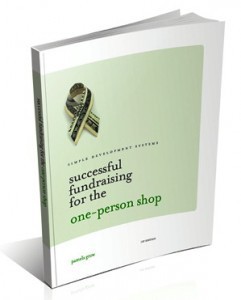 A few months ago, my colleague Pamela Grow released a new book specifically for nonprofits with a “one person” fundraising shop. This isn’t just theory for her, she actually has been successful as a one person shop. So, since I love small shops-and even contributed a chapter to this book-I interviewed her about her approach.
A few months ago, my colleague Pamela Grow released a new book specifically for nonprofits with a “one person” fundraising shop. This isn’t just theory for her, she actually has been successful as a one person shop. So, since I love small shops-and even contributed a chapter to this book-I interviewed her about her approach.
Here is some of the transcript of some that interview. (Like I do with all books I mention on this blog, the links to this book are affiliate links.)
Me: Hi Pamela! Simple Development Systems: Successful Fundraising for the One-Person Shop is clearly written for small shops. What’s different about being responsible for doing it all rather than being a part of a larger development team?
Pamela Grow: Well Marc, whether you’re an executive director who is also responsible for doing the fundraising (until you can hire someone) or the development director of a one-person shop, being responsible for everything – from grant proposal writing, to individual giving, to database management, to online giving and creating a website, to social media and MORE – it’s easy to get distracted by every bright shiny new object that comes along.
What Simple Development Systems does, according to one reader, is to “focus your efforts in the places that will have the largest impact.”
ME: Focus is so important! What are some of your recommendations for focusing?
PG: Focus can be hard, can’t it? We’re living in an ADHD world with more distractions than ever before. You know yourself, Marc, the distractions that come from balancing client work, with speaking engagements. And social media. And blogging. Not to mention family life! There just aren’t enough hours in the day.
And this is where I’m going to spout that old Yogi Berra quote:
If you don’t know where you are going, you might wind up someplace else.
It’s true, isn’t it? You’ve got to, first off, create a solid plan.
How much can you reasonably expect to raise from grants this year?
How will you grow your individual giving?
Does your individual giving plan include growing online giving?
Are you creating a monthly giving program? (BTW, I’ve got a recording of a wonderful call I did with Harvey McKinnon who literally wrote the book on monthly giving, Hidden Gold, in Simple Development Systems .)
If you’ve got a monthly giving program – and you should, how will you be growing it?
So you’ve got to create a plan first. Then, well you’ve got to WORK it! Simple Development Systems guides the reader through the steps to creating a workable plan for sustainable funding.
Me: Helping with creating a fundraising plan is essential. What about the motivation to keep actually implementing the plan?
PG: Motivation, well that can be tough too, can’t it? We are virtually surrounded by negativity on so many levels. My advice? Turn it off. Listen to motivational recordings on your ipod while you’re working, start your day with some intense cardio (I get my best ideas when I’m running on the nature trail in the morning), bring a hula hoop to work! Have fun!
It’s also so important to get away from desk: whether it’s to visit with donors, to spend some time observing your organization’s programs or even to answer phones or greet people at the front desk. Get a different perspective!
And remember: your fundraising will be easier when you’re tough on yourself. Resist that urge to check your email or Facebook or Twitter! If you’re constantly checking email, check out installing something like Leechblock. What this tool does is block the sites that you specify.
MP: Great point. The tougher we are on ourselves, the easier our task will be. At least in my experience!
I know when we’ve spoken before that you’ve said that shifting your focus from money to building relationships will take all the stress out of fundraising and raise more money too. What do you mean by that?
PG: It’s pretty simple. When you’re focused on raising money, you’re focused on the short-term. When you’re focusing on building relationships with supporters, you’re focused on the long-term stability of your organization.
And, of course I don’t mean – ever – to abandon your ASKS. We all know the importance of creating a system of asks.
As a one person shop with overwhelming responsibilities, one of your daily non-negotiable habits should be spending 30 minutes to an hour connecting with donors. How can you do this? As simple as calling them to thank them for a gift.
Several of my clients have balked or put off making phone calls. You might need a sample script when you make that first call or two. You might feel awkward – I know that I did – heck, even when I was in sales I preferred the face-to-face over a phone call – so create a script. Be personable, be genuine.
Another tip is to keep a drawerful of thank you cards and note cards and send out one handwritten note a day – to a volunteer, to a donor, to a board member – expressing your gratitude for their contribution to your organization. I learned from my grandmother that gratitude plays a key role in everything you do – I know that you know that to be true too, Marc.
MP: You’ve got a lot of resources in Simple Development Systems I know since I contributed an article on social media!  What was your reasoning behind that?
What was your reasoning behind that?
PG: I do! There’s a 90 minute recorded webinar on how to write donor newsletters that raise money from the brilliant Tom Ahern, teleseminars from Harvey McKinnon and Mal Warwick and contributions from a slew of amazing people, including Ken Burnett, Mazarine Treyz, John Haydon, Gail Perry, and more.
And the reasoning behind that is that I want to expose people who are new to fundraising to the absolute best resources out there. There’s a lot of misinformation in our sector – a lot of information that simply doesn’t apply to “small shops.” I wanted to only include what would help a small shop.
MP: What one piece of advice do you have for nonprofits who need to establish a solid base of funding?
PG: Well, I’m a big believer in applying sound donor-centric strategies across the board – even in terms of grantseeking – and that’s what Simple Development Systems is all about.
A huge problem in our sector, one that we talk about constantly, is donor retention. if anyone reading has not read the book Relationship Fundraising by Ken Burnett, I highly recommend it. Ken prefaces every chapter in the book with a “Donor Profile,” an in-depth story about one particular individual and how and why they give. Each profile describes in depth a particular donor’s day to day life, his/her likes and dislikes, the kind of car that he/she drives, even their upbringing.
I think that there are a lot of professional fundraisers who still don’t truly grasp the concept of donor-centered fundraising and think its some sort of trend in the nonprofit world when, in reality, it is the only legitimate – I would even venture to say the only honest – method to long-term, sustainable funding.
What we fundraisers often forget is that the “who is so much more important than the what.” We’ll spend hours crafting our mission statement or our organization’s story – without giving the slightest thought to the person who is reading it!
The surest way to strengthening your fundraising is by doing a donor profile. Truly envision that person. What they do for a living, what they wear, where they live, how many children they have, where they worship – give that person a name!
You might have more than one donor profile – but figuring out who that person is is going to absolutely streamline your fundraising and marketing.
Think about it this way Marc – when you’re researching a prospective foundation funder, don’t you try to find out everything that you can about that funder prior to drafting your proposal? Why wouldn’t you do that with all donors?
I think that gives you a sense of Pamela’s thought process and the style in Simple Development Systems. On the Simple Development Systems you’ll see more about the book and comments from people who’ve found it to be a lifesaver in their own one-person, small nonprofit fundraising shop.
More information is available at: Simple Development Systems
Another tool that Pamela and I worked on and has been incredibly useful for small shops is 100 Donors in 90 Days. You can learn more at www.100Donorsin90Days.com
(c) The Fundraising Coach, LLC
Get 100 donors in the next 12 weeks? Learn how: 100 Donors in 90 Days!
Other Possibly Related posts:
Fundraising Secret #16: ALWAYS be interested in the donor as a PERSON
How to survive as a small shop
[Question Marc] When do you ask a person on Twitter to follow you?
September 4, 2012
100 New Donors by December 3rd
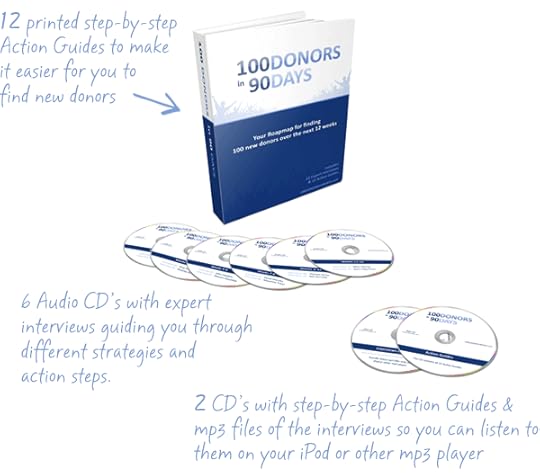 It’s September! How are your fundraising goals going?
It’s September! How are your fundraising goals going?
Could you use 100 new donors by December 3rd?
I know that sounds like “hype” that a snake oil salesman would use. But this isn’t hype, this a set of 12 action-oriented interviews for bringing 100 new donors to your nonprofit.
You’ll get all 12 interviews on CD to listen to when it’s convenient for you. And you’ll get all 12 printed action guides so you can put the tips into action each day.
It really works
We just asked people who’d purchased the program how they were doing. One woman said she got 213 new donors. 213!! Another man said that, despite not being able to put all the tips into practice, he still get 180 new donors!
What would that many new donors do for your year end fundraising? And once you’ve had a year to develop a relationship with them, how much more might that give next year?
No risk trial
Ha! I bet a headline like “no risk trial” sounds like hype too. But it’s not. You have a full month to evaluate the program. If you don’t start seeing results in 30 days, you can get a full refund.
Check out the testimonials and the program at 100 Donors in 90 Days or http://bit.ly/100in90.
(c) The Fundraising Coach, LLC
Get 100 donors in the next 12 weeks? Learn how: 100 Donors in 90 Days!
Other Possibly Related posts:
Extreme Fundraising Special Edition—December 29, 2003
Could you use 100 new donors in the next 90 days?
3 Common Questions about 100 Donors in 90 Days
August 28, 2012
Get over it and ask!

[Warning: rant in progress]
Stop it with the excuses. The timing is never perfect. There are always reasons to put off asking people to support your nonprofit.
And that is a sure way to get your nonprofit bankrupt.
If your nonprofit is doing important work, people will want to fund it. But they won’t come to that conclusion all by themselves. They need you to invite them. You need to ask.
Get the excuses out on paper
We human beings have an amazing ability to create excuses. Last week, I had the attendees of my “Ask Without Fear!” full day training in Texas write down one excuse per post-it note. Those 35 people came up with around 300 excuses of why people wouldn’t give.
Over 300 in under 10 minutes!
The timing isn’t right because
it’s still the summer
it’s the start of school
summer’s almost over
it’s going to be winter in a few months
they just sold the house
they just bought a house
they are in their other home
they probably won’t like what we’re doing anyway
they probably are giving to other causes
they have kids/grandkids/friends with kids
it’s rainy
it’s sunny
stocks are up
stocks are down
there’s a hurricane warning in a distant part of the planet
there’s a lot of sun out
their budget is probably spent
they haven’t returned the call I left them 4 minutes ago
they have relatives visiting
business hasn’t been good for them
business is so great they don’t have time
we’ve asked them too recently
we haven’t asked them for so long
They all stuck the post-its on a wall and then a few of us worked on clumping them into common themes. We got it down to 10 basic excuses. And as a team, we came up with responses for each one. You could see people grow in confidence right before our eyes.
Start treating your donors like adults
All of those excuses may be true, but you’re refusing to ask is effectively telling your prospect they will say no. Who do you think you are? Can you read their mind? I’ve been married 17 years and still can’t read my wife’s mind. How in the world would I dare presume to read the mind of anyone else?
Treat your prospects like adults and let them make their own decision. Sure, some of them will say no. But not all of them will. And some of them who say no to the level you request but will say yes at a different gift level.
And get out there and ask for money
Even if you work alone, this week, write out all the reasons why you think this is a bad time to ask people for money. And then cross each out and right out a reason why it is a great time to ask! You’ll be amazed with how energizing this can be. You’ll feel your confidence grow.
Use that newfound confidence, however small, to go out there and ask people for money. Get on the phone and set up appointments.
We’re moving into the time of the most significant giving of the year. Studies show 23% of all donations are made in December. Get those asks in motion now!
[Rant over]
What do you do to get over inertia?
Join the conversation and let us know what you do to get over the inertia and excuse making!
(c) The Fundraising Coach, LLC
Get 100 donors in the next 12 weeks? Learn how: 100 Donors in 90 Days!
No related posts.
August 24, 2012
3 Ways the Lance Armstrong Foundation can Survive
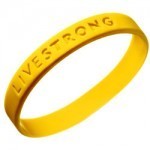 Today’s news is reporting Lance Armstrong’s decision to not fight the doping charges. Many are saying he’s basically admitting he’s guilty.
Today’s news is reporting Lance Armstrong’s decision to not fight the doping charges. Many are saying he’s basically admitting he’s guilty.
Herein lies one of the biggest challenges for nonprofits that are branded around a personality.
Nonprofits with personality are wonderful to work with and find it easier to gain supporters. People can identify with people more quickly than they can with an “organization.”
But riding on the coattails of one person’s personality leaves you open to problems when that person falls from grace (either in reality or simply in public perception). The Lance Armstrong Foundation faces a rocky phase despite all the good it’s doing in educating on cancer, helping raise awareness about prevention, and even giving inspiration to those fighting the battle.
Here are 3 ways the Lance Armstrong Foundation can do to survive this:
Tell the troops NOW
The Foundation needs to get ahead of the story. Ideally, they would have started before Lance made his announcement. The charges aren’t new, so they probably already have an arsenal of arguments and comments to help them frame the story their way. I’d encourage them to narrow the arguments to three points that they can repeat, repeat, repeat. Lance’s own statement definitely gives them a start.
Harness social media NOW
I heard the news on NPR and felt the coverage was balanced. But not all media will be so kind. The Foundation needs to call on all the support and brand equity they’ve established over the years and get their fans active online. Simply asking their fans what the Foundation has meant for them will have tremendous power. The more positive stories of impact the Foundation can have others put online, the better.
Start damage control with sponsors NOW
NPR reported that being stripped of the 7 Tour de France titles and banned from the sport means that Lance can’t compete in any triathlons or Ironman competitions. Apparently, those were linked to million dollar contracts. So Foundation staff will need to work with Nike and all their other contracts to reassure them that the good the Foundation is doing is great for the company brand, far outweighing any legal challenges Lance is facing. That will be a tough argument and some sponsors will be lost, but I believe the damage can be mitigated.
This will be a busy weekend for the Foundation staff. Hopefully, they’ve been working toward this for weeks so they’ll be able to come out strong. But, since nonprofit founders don’t always communicate their decisions well with their nonprofit staff, this may be catching them by surprise. An interesting decision the board will want to examine is if the Foundation needs to distance itself as a brand from Lance. Or if part of the Foundation’s mission will now be to defend Lance’s legacy.
What would you add?
Those are the first three things I’d advise the Lance Armstrong Foundation staff to work on. What about you? Do you think they can weather this storm? What would you recommend they do?
(c) The Fundraising Coach, LLC
Get 100 donors in the next 12 weeks? Learn how: 100 Donors in 90 Days!
Other Possibly Related posts:
What’s the One Secret to Winning Foundation Grants?
Guidestar helps people donate to Inland Foundation
How to survive as a small shop
August 14, 2012
6 funky ways to use your calendar
While I miss my old school Franklin Planner, I love the convenience of my Google Calendar.
Over the years, I’ve developed some unconventional uses for my calendar. Here are 6 of them.
Non-family birthdays:
I’ll start with the most banal first: birthdays. Whenever I learn of a birthday of a friend, client, or most anyone, I put it in my calendar. With an alert to remind me a couple days in advance. This allows me to send a “Happy (early) Birthday” email to folks. (Plaxo also helps with this.)
Notes to your spouse:
Early in our marriage, my wife got frustrated enough with me to blurt out: “If I were and alum you’d have time for me!” The worst part was she was right. When I was younger, I used to send notes to her. So a year or so ago, I started using my calendar and Send Out Cards to say what I meant without having to find cards at a store. You schedule your staff meetings, why wouldn’t you schedule reminders to tell your loved ones you love them?
Remind yourself of your priorities:
 With all the appointments that come at us during the course of a week, our schedules can become incredibly fragmented. One of the great things about online calendars like Google Calendar, is that you can use multiple calendars.
With all the appointments that come at us during the course of a week, our schedules can become incredibly fragmented. One of the great things about online calendars like Google Calendar, is that you can use multiple calendars.
In the image on the right, you can see I’ve created a “time blocking” calendar. I don’t share this with anyone. This is just for me. It’s amazing how helpful this is when I’m on the phone with a prospective client. With this additional calendar, I remind myself when I feel I’m at my best.
You can see how it looks. The blue are my appointments, the ones anyone can see if I share that work calendar with them. But the red are the reminders of how I want to spend my time. I like coaching clients early in the week. And I like speaking and training later in the week. So I have that reminder plainly in front of me.
The blue is reality. The red is ideal.

Maintenance reminders:
We all have regular things we need to do. Online calendars make it incredibly easy to set up these repeating appointments, at whatever interval is appropriate. Some idead include:
Each of your direct mail appeals (bi-monthly or quarterly)
thank you’s to donors (monthly)
debriefing after your annual event (annually)
dates with your spouse or kids
just about anything you can think of!
If you get to that appointment and find it’s not at a convenient time, you can always move it! But at least it’s there to move!
Toss out your to-do list:
Everytime I give my time-management seminar, I’m told this is the most helpful tip. If you’re like me, you love creating to-do lists but find it far to easy to not look at them again. (The online task lists are even easier for me to ignore.)
These lists become garbage barges of tasks. A constant reminder of how you’re falling short.
Blow up the barge! It’s a mind drain.
If something is important enough to add to a to do list, it’s important enough to add to your schedule. So why not just put it there? Like the step above, you can always move that task on your calendar, but at least you’ve blocked time to get it done.
It’s an amazing feeling to open up your calendar, feeling pressure to get something done, and seeing you’ve already blocked out time to do that today!
Keep your attitude focused:
This is my favorite tip of them all! Despite my disciplined approach to each day, I still find my thoughts turning sour. In just the last month or so, I’ve started using my “time blocking” calendar to schedule attitude vitamins. The current two vitamins I have are:
Monday at 10:30 a.m. a reminder pops up: You will be taken care of
I love the Ennagram and I get a daily email with reminders about how to be my best self. As a 7, the reminder that I’ll be taken care of is something that frees me up from freaking out. Even though I’ve scheduled this, it still is an amazing peace-filling reminder every Monday.
Thursday at 10:30 a.m. I see: blessings are chasing me down and overtaking me
I recently saw my friend Carrie Wilkerson tweet this phrase. It spoke to something deep in me so I immediately set it up as a weekly reminder. It’s amazing how important this one phrase is and how timely it seems to hit even though it’s pre-scheduled!
I’ve limited this to two attitude vitamins. This helps them remain a “surprise” for me. I think anything more frequent would become annoying.
Those are my 6 ideas, what would you add?
Tell us in the comments below!
(c) The Fundraising Coach, LLC
Get 100 donors in the next 12 weeks? Learn how: 100 Donors in 90 Days!
Other Possibly Related posts:
7 ways to thank a donor
2 easy ways to get free PR in 2012
Ways to help spread the word
July 20, 2012
Google+ is suddenly more relevant for nonprofits

Yesterday HootSuite [affilate link] announced support for Google+ Pages!
Back in November, I blogged about Google+ being open for nonprofits. But one of the hardest things for nonprofits has been the fact that they have to remember to go to the Google+ site rather than using their social media tools like HootSuite.
Suddenly, Google+ is more relevant for nonprofits
HootSuite’s integration allows you to monitor your page and your Google+ stream from right within HooteSuite. You can even choose the circles you want to share posts to, just like on Google+.
You can read all about the HootSuite Google+ integration on their blog. There’s even a quick video explaining why Google+ pages are so much better than other social media platforms.
Fastest growing social media network
While I’m not suggesting you ditch your Facebook presence, you really need to check out Google Plus. It continues to be the fastest growing social media platform. Facebook, YouTube, and Twitter were still the top social media sites last month here in the USA, but Google+ had more users than LinkedIn or Tumblr or Pinterest. Google+ might not be getting great press, but it sure is getting more users.
Those users could be your donors.
What are you waiting for?
To learn more about how Google+ can help your charity, check out my forthcoming “Google+ for Nonprofits”.
(c) The Fundraising Coach, LLC
Get 100 donors in the next 12 weeks? Learn how: 100 Donors in 90 Days!
Other Possibly Related posts:
Google+ is open to nonprofits
Google+ for Nonprofits at BlogWorld Expo in LA
Google for Nonprofits
July 17, 2012
Don’t fire blanks with your email
It’s summer here in the Northern Hemisphere. Summer can be a great time to take care of that list of things you were planning on doing “when you had time.”
Perhaps you could revisit your nonprofit’s emails.
Don’t let your emails look like this
Check out this email I recently received from one of my favorite brewers:
Kind of hard to read, isn’t it?
I can’t tell you how many emails I get from nonprofits each month that look almost like this.
Many people don’t allow images
One of the first things I learned about email safety was to only display images from trusted sources. Apparently, some creative bad guys can put bad programs on your computer through images. It’s far to techy for me. But I just decided not displaying images was easier than letting my computer get hijacked but a rogue program.
I bet I’m not alone.
Your image-laden email may look pretty. But what if your readers can’t see it?
A simple solution
If you use an email provider like AWeber [aff link], you have two options for your email: HTML and plain text. (Constant Contact offers this feature too.)
These providers “sniff” out whether subscribers are able to see images or not. If they can, they get your pretty image. If they can’t, at least they’ll see your message.
Does it take a few extra minutes to make sure your HTML message works as a plain text message. But if your message is worth sending, isn’t worth taking a little extra time to make sure your readers can see it?
(c) The Fundraising Coach, LLC
Get 100 donors in the next 12 weeks? Learn how: 100 Donors in 90 Days!
Other Possibly Related posts:
Email fundraising
Building your nonprofit’s email list
Effective email
June 22, 2012
FundCoaches: A revolution in fundraising training
I’m thrilled to announce the launch of FundCoaches.com!
Have you noticed how hard it is to find high quality, extremely practical, and affordable fundraising training?
That inspired me to work to make it ridiculously easy for people to get fundraising training. I offer books, DVDs, and downloads in addition to presenting in-person around the world.
A call from out of the blue (Ok, really a call from Canada)
So I was intrigued to get a call from Mo Lidsky, a fundraiser at Yeshiva University. He’d come into philanthropy from a business background and couldn’t believe how hard it was to find cost effective, CFRE standard training. Usually you have to go away to conference, paying travel and lodging expenses in addition to paying the conference registration. He couldn’t believe there wasn’t any place for people to get affordable training without having to leave their office.
So he pulled together Simone Joyaux, Tom Ahern, Ted Hart, and myself to produce high-quality fundraising training that would be incredibly affordable. We call it FundCoaches.
Strict standards
Mo and his team flew around the country filming us presenting our training. He had three requirements:
that we deliver practical content that would help staff and board members,
of a high enough quality to qualify for CFRE requirements, and
that we do each topic in 20-30 minute segments
He wanted you to be able to watch one of our modules while you ate your lunch. And he didn’t mean watch some PowerPoint slides. He wanted you to be able to actually see us.
For prices as low as $16.99, you can have video content to help you or your board members advance your nonprofit’s fundraising.
Terrific Topics
You can learn from modules including:
“Successful Direct Mail” and “How to Market Bequests to Donors” from Tom Ahern
“Developing the Best Grant Proposal” and “Stewardship Secrets to Keeping Your Donors” from Simone Joyaux
“LinkedIn Fundraising” and “Governance and Board Fundraising” from Ted Hart
“Creating Donor Evangelists” and “Effective Email Solicitation” from me!
Special Discount
And for a limited time, I’m able to offer you 50% off a module. Just got to FundCoaches.com, choose your module from the store, and use the code: NLSBINUP
Some FundCoaches production pictures
(c) The Fundraising Coach, LLC
Get 100 donors in the next 12 weeks? Learn how: 100 Donors in 90 Days!
Other Possibly Related posts:
SPECIAL: Free Fundraising Coaching 1-on-1 Call with purchase of Fundraising Training
Fundraising Training Videos now available online!
Services: Executive coaching & customized fundraising training
June 19, 2012
Dialing for dollars
For many of us, June is the end of the fiscal year.
Most donors could care less. But that doesn’t mean we can slack off!
A deadline is a great motivator. So even if it is a deadline that makes no sense to donors (donors think in terms of the tax year), it can still motivate a gift.
Here are some steps I shared last week with my Fundraising Kick subscribers that will help you get on the phone and ask for money!
Decide which is more important to your nonprofit:
raising money to meet goal or
increasing the number of donors.
I’m serious. For many of you, dollars in the door are the most important. But some of you have already hit your goal. If that’s the case, use this month to get even more donors in the door.
Next run a list of all the people that gave last fiscal year (last July through last June).
If you need to raise more money, sort the list from biggest gift to lowest.
If you want to get more donors, you might want to sort it by lowest gift first.
Start calling! Either goal, set aside at least an hour a day for calls.
These calls aren’t for setting up appointments. This is straight dialing for dollars.
“Hi, this is ________ from [nonprofit name]. We’re grateful for your support in the past and were wondering if you’d be able to make a gift before our fiscal year ends on June 30.”
Be sure to be able to take credit card numbers over the phone. That is the best way to go. It’s easier for them and it’s money in the bank for your nonprofit.
And have fun bringing in the dollars and donors. Seriously. This is a part of fundraising!
What phone fundraising tips would you add?
Let us know in the comments!
For three more simple tips on fundraising by phone, check out my YouTube video: 3 quick tips to make your fundraising calls more effective
(c) The Fundraising Coach, LLC
Get 100 donors in the next 12 weeks? Learn how: 100 Donors in 90 Days!
Other Possibly Related posts:
Dialing for Donor (visits)
3 fundraising ideas for a strong finish to your fiscal year





